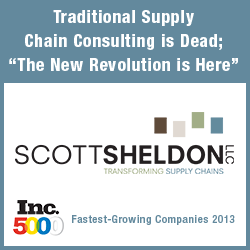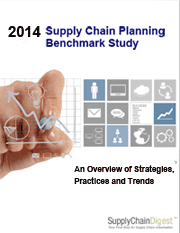 |
November 22, 2013 - Supply Chain Flagship Newsletter |
 |
| THIS WEEK'S SPONSOR: SCOTT SHELDON |
 |
Back to Thinking "Inside the Box" |
 |
|
|||||||||||||||||||||||||||||||||||||||||||||||||||||||||||||||||||||||||||||||||||||
A Decade of Supply Chain Mega-Changes
|
||||||||||||||||||||||||||||||||||||||||||||||||||||||||||||||||||||||||||||||||||||||
| GILMORE SAYS: |
"Clearly in the consumer goods and retail sectors, as we move to forecasting each SKU at a store level, the number of DFUs per planner will explode." WHAT DO YOU SAY? |
So, in mostly random order, here is my list of the biggest changes in supply chain over the past 10 years, starting with some technology issues but moving on from there:
Technology Vendor Consolidation: Stated bluntly, the supply chain technology landscape has been altered substantially over the past decade due to mergers and acquisitions. On the ERP side, in 2003 JDEdwards and PeopleSoft were still independent companies. So to were Retek (retail software) and G-Log (TMS) and Demanta (demand planning). All the above were acquired by Oracle in the mid-2000s.
Supply chain software icons Manugistics and i2 were still independent companies, as was RedPrairie (which itself made a series of acquisitions in the middle of the decade). Now all are part of JDA Software. In wireless devices for logistics and manufacturing, consolidation has left the US market basically with just two providers, Motorola Solutions and Honeywell.
There are certainly still smaller vendors out there in most areas, and Cloud-based solutions may start to deliver a new set of choices for the market, but at the large and mid-sized vendor level the number of available solutions has shrunk dramatically over 10 years. Of course, there has been quite a bit of consolidation in most regular business sectors as well over that time.
Dramatically Improved Software Quality: Ten years ago, most supply chain software was subject to at least occasional major problems with software quality - "bugs" - which sometimes had major ramifications. Often, this was a result of substantial customizations required to meet functional needs that went awry, as was the case in 2001 when Nike blamed a new i2 deployment for massive inventory problems and a blown financial quarter. As an industry analyst in 2002, I counseled a pretty large company that just couldn't get JDEdwards to work. It wanted to know if it could get its money back.
Today, the code is simply much better. Functional advances and a better recognition of the risks have dramatically reduced the levels of customizations. Cloud-based solutions generally eschew the idea of customizations altogether. Software will never be perfect, but in 10 years the kind of major software quality issues commonly seen back then are almost unheard of today. Problems that arise are now usually from configuration issues, not bugs. That is an important change, and greatly reduces risk. I can't overstate how much this has changed in 10 years.
RFID's Supply Chain Collapse: Staying on a technology theme on last time, 2003 and 2004 clearly represented the apex of RFID hope for the supply chain. Walmart's mandate was announced, the EPCglobal organization was formed, consumer goods companies like Procter & Gamble and Kimberly-Clark were spending big dollars on research, RFID testing labs were sprouting like weeds, etc.
Walmart's program frankly was wobbling shortly after the launch, but was reeling by 2007 or so, and was basically dead by 2009. What a dramatic change from the vision that was driving much of supply chain thinking in the first few years. Other retail RFID high-flyers such as the UK's Tesco and Germany's Metro Stores similarly retrenched. This all simply altered in a dramatic way the trajectory of where we thought supply chain was going.
RFID has received a bit of new life with the slow progress in item-level tracking of soft goods (e.g., Macy's), and as this (gradually) evolves, I believe it will eventually lead back to case-level tagging, just as the UPC code on items in a sense eventually led to UCC-128 serialized bar codes on cartons. And in the end, RFID is just generally better and someday will win out when there is a tag cost breakthrough. But the energy behind RFID in the distribution center or for widespread supply chain visibility is just a fraction of what it was 10 years ago. Quite a story, actually.
Searching for Growth in Emerging Markets: China entered the World Trade Organization in 2001. Offshoring to low cost countries in the apparel and high tech sectors, among others, was already well underway in the 1990s. China may have exploded as a force at a bit higher level than many expected in 2003, but in general I don't think there has been that dramatic a change on the supply side.
 What has changed significantly is the focus on emerging markets as the only real source for strong growth on the demand side. The Great Recession, slow recovery in the US, and the subsequent extended contraction in many parts of Europe ever since have caused multi-national corporations to desperately search for growth in developing markets. That simply wasn't really the thinking in 2003.
What has changed significantly is the focus on emerging markets as the only real source for strong growth on the demand side. The Great Recession, slow recovery in the US, and the subsequent extended contraction in many parts of Europe ever since have caused multi-national corporations to desperately search for growth in developing markets. That simply wasn't really the thinking in 2003.
This change of course has many supplier chain ramifications. How does product get into a given country, and how does it move within its borders? How do products need to be redesigned to meet the functional, price point and other requirements of the developing country customer (factors which of course vary between regions/countries)?
I've twice seen Walmart's Gary Maxwell give excellent presentations on the company's strategy to really tailor its supply chain to the needs and cost realities of each market it enters , versus the "best in class" approach Maxwell sees some have taken across the globe. German industrial giant Siemens has been one of the leaders in designing products specifically for emerging market realities. Procter & Gamble sells laundry detergent by the cup full in parts of India.
But it's far from just large companies hoping for growth in emerging markets. All of which provides lots of opportunity for supply chain managers and global 3PLs.
Risk Management Moves Way Up the Supply Chain Priority List: There was an emerging sense that supply chain risk management needed a lot more attention than it was receiving in 2003, but the difference between then and now is simply staggering.
Obviously, the rise of global sourcing is largely behind that, as well as research and case studies in the 2000s showing the impact on stock price, market share, and/or brand reputation from supply chain disruptions.
In more recent years, a series of major natural disasters such as the Japan earthquake and tsunami that put a wallop on Toyota and much of the rest of the auto industry, the flooding in Thailand that put a similar hurt on the high tech sector, the Icelandic volcano that impacted hundreds or thousands of companies, etc. , showed many companies they had major supply chain risks about which they were almost totally unaware and unprepared.
Add to that the now powerful recognition that there is also a large personal risk for supply chain executives for not getting this complex equation right: keep costs world-class low, while you are eliminating any chance for a dynamic supply chain disruption. Good luck with that, but that is precisely the lot of many chief supply chain officers today. That simply wasn't true in 2003-04. Hugely different scenario today.
So as usual I am out of room. The next five most important supply chain changes over the past 10 years is coming in two weeks, following our newsletter vacation we will take next week for Thanksgiving (one of just four such SCDigest newsletter holidays each year).
The other five mega-changes we'll cover then are: the rise of green supply chain practice (obvious but true), omni-channel and the Amazon factor; focus on supply chain finance; supply chain now in the boardroom; and the tremendous advanced in distribution center automation.
Any thoughts on the largest supply chain trends of the past decade? We still haven't written part 2 - any suggestions? Let us know your thoughts at the Feedback section below.
| View Web/Printable Version of this Page |
|
|
|
YOUR FEEDBACK
We received a number of nice letters on last week's Supply Chain History Project column, some just saying "great idea," others offering some history tidbits. A selection of those emails is provided below. Probably a few more next week.
That includes our Feedback of the Week from Mike Regan of TranZact Technologies, who adds some additional history relative to the first transportation Load Control Center at 3M.
Feedback of the Week, on the Supply Chain History Project
Very interesting column and idea. You should have contacted me. I knew Roy Mayeske and another gentleman that worked for him at 3M, Larry Hall. With respect to the software, guess who owns that software today? Yours truly. It was ultimately sold to CSC and we bought it from them in 1999. We named the product StarPlan. If I am not mistaken (and I may be),the person at Schneider who got the product going was a rising hotshot named Chris Lofgren - who is the CEO of Schneider today. When Schneider bought us in 2000 Chris was in charge of the deal and I talked to him about this. Once again, I may be wrong, but the product was initially conceived by optimal decisions out of Cinci, Ohio and was debuted at a NITL Transcomp show.
Great thing you are doing. Mike Regan |
||
Dan, suggest you connect with Cliff Lynch. He was VP Logistics at Quaker Oats in the 1970's, when I believe he sponsored the first (or at least the best at that time) Network Design project. We used an innovative nonlinear optimizer developed at MIT for that (I was at TBS at that time...Cliff remains a good friend...and he is among the best logistics leaders ever).
I can't remember what I did yesterday let alone in the 1970s.
Seriously, as Gene pointed out Quaker engaged Temple Barker & Sloane to do this network analysis in 1973. At that time I don't recall anyone else having done it, but I wouldn't stake my life on it.
It was an excellent piece of work however and gave us a network that held up against at least three more analyses while I was there.
Clifford F. Lynch Sounds like it was very early, but pretty sure the DelMonte project in 1972 was the first, as we showed in the timeline video. Dan Gilmore |
||
You seem to be focusing on modern day supply chain management. If you are going to do a history of supply chain you should at least cover the Roman Civilization’s contributions. The "all roads lead to Rome" concept allowed goods and information (via couriers) to flow in and out of Rome's hub-based logistics control center. An excellent book "Movable Feasts" is a good source of info on the ancient food supply chains. Lawrence (Larry) Lapide, Ph.D. Research Affiliate MIT Center for Transportation & Logistics Editor's Note: Thanks Larry.
To be clear, the video was tied to the 50 years of CSCMP, so it would go no earlier than 1963. The older stuff is either known or lost. I am not saying I will ignore the older stuff (we had the Ford assembly line and "Taylorism" as two of our 10 greatest supply chain innovations of all time) but I am most concerned about stuff that if it isn't captured now, will be lost (can you believe no one as a copy of Mesher's 3Vs research notes?) and putting it all in one place. I will certainly go back a ways...to the Romans? Not sure. Dan Gilmore |
||
Just had the opportunity to view the video depicting milestone supply chain events during the past 50 years. What a great job. Sure, my list might be a bit different but anyone who has been around for a while could say the same. I would like to have a copy to show some peers and those on my team.
Director of Global Logistics iRobot Corporation
|
SUPPLY CHAIN TRIVIA ANSWER
Q: What do Gillette, Hewlett-Packard, Johnson & Johnson, Kimberly-Clark, Kraft Foods, Nestlè Purina PetCare, Procter & Gamble and Unilever have in common?
A: They were the eight companies sending RFID tagged cases to a Walmart DC in Texas as part of a 2004 test before the planned rollout of the program in January, 2005. That rollout sort of happened, but not really.
| © SupplyChainDigest™ 2003-2013. All Rights Reserved. SupplyChainDigest PO Box 714 Springboro, Ohio 45066 |
POWERED BY: XDIMENSION
|








